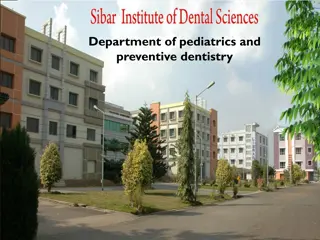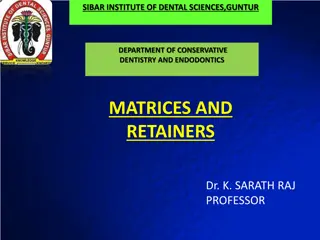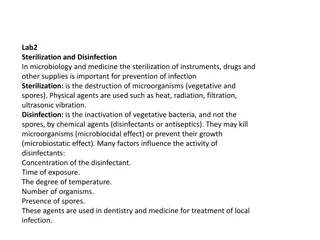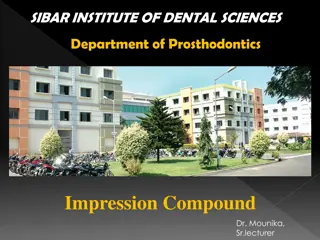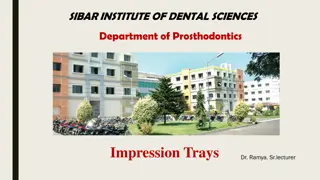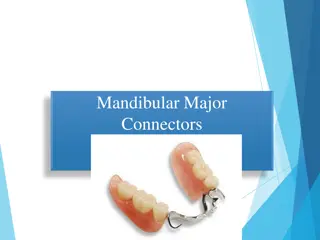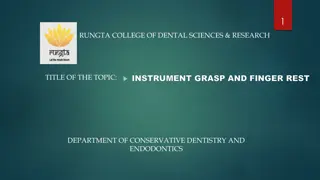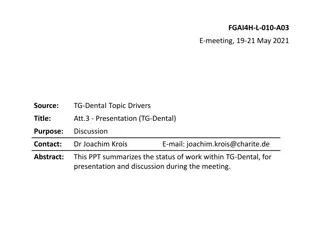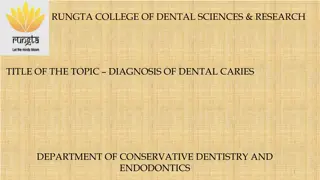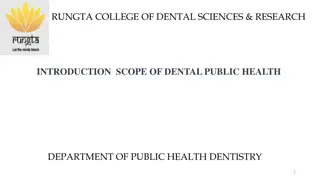Understanding Repair and Addition to RPD in Dentistry
The need for repair or addition to an existing Removable Partial Denture (RPD) often arises due to various factors like occlusal disharmony, improper handling, or fatigue of metal components. Common fracture sites include midline, clasp fracture, and acrylic saddle detachment. The repair procedure involves accurately reassembling fractured pieces and reinforcing them with sticky wax. Proper diagnosis, mouth preparation, and effective RPD design can minimize the need for repairs or additions.
Download Presentation

Please find below an Image/Link to download the presentation.
The content on the website is provided AS IS for your information and personal use only. It may not be sold, licensed, or shared on other websites without obtaining consent from the author. Download presentation by click this link. If you encounter any issues during the download, it is possible that the publisher has removed the file from their server.
E N D
Presentation Transcript
Introduction The need for repair or adding to an existing R.P.D frequently arises and by careful diagnosis and with adequate mouth preparation, and carrying out the effective R.P.D design are to be accomplished all together will minimize such a need.
Introduction Any need for repairs or additions will be the result of unforeseen complications arising in the abutments of in other teeth in the arch, or to breakage or distortion of the denture through accident or careless handling by the patient rather than a faulty design or construction.
Common sites of fracture: 1. Midline mainly due to occlusal disharmony. 2. A tooth detaching from the denture, mainly due to improper application of separating medium during packing. 3. A peace of flange may be lost mostly due to improper handling. 4. Clasp fracture mostly due to fatigue of metal that result from: Repeated flexure especially with too sever undercuts exposing as much gingival tissues as possible. Structural failure of the clasp arm: a cast clasp arm that is not properly formed is subjected to careless finishing and polishing will eventually fracture at its weakest point. Careless handling of the patient.
Common sites of fracture: 5. Occlusal rest fracture: the point of weakness in an occlusal rest is where it crosses the marginal ridge, that is due to improperly designed and prepared occlusal rest seat causing fracture at that point. 6. A clasp is repaired by soldering. It may be necessary to alter the rest seat of the broken rest, or relieve any occlusal interferences before carrying on the repair procedure. 7. Fracture of anterior maxillary saddle area with one or more teeth.
Common sites of fracture: 8. Acrylic saddle detaching from a chromium cobalt denture base. 9. Distortion or breakage of other components such as major or minor connectors. 10.Loss of an additional tooth on teeth not involved in the support or retention of the restoration.
Repair procedure: 1. Accurately reassemble the fractured pieces, any differences may cause the denture either not fit or does not occlude correctly. 2. Sticky wax applied to the fractured pieces along the fracture line, to maintain them in a correct position. 3. A wooden match stick is added on either side along the occlusal surfaces of the teeth attaching them with sticky wax. To reinforce the fractured pieces.
Repair procedure: 4. Block any tissue undercuts by pumice mixed with cotton sever, a cast is poured with plaster. 5. After the cast is set separate the fractured R.P.D pieces, removing the sticks or the sticky wax. 6. Apply separating medium to the cast. 7. The fractures edges are to be leveled towards the polished surface which should be reduced with grooves of (8-10 mm) zig zig, the pieces are them re-assembled on the cast.
Repair procedure: 8. A mix of self cured acrylic resin is applied either though pouring a thin alternately monomer and polymer (sprinkle method), over filling to allow an excess amount for adequate polishing and thus compensating for expected shrinkage. 9. A pressure curing unit of (30 pounds) will enhance the density of the resin for (10 minutes) curing period. 10. The R.P.D is then finished, polished, in the usual manner.
Repair of a fractures or missing tooth: 1. Reduce the area lingual to the fractured or missing tooth, while the labial area should remain intact to aid in correct positioning of the new tooth, thus seating the tooth without any interference. 2. Determine and select a proper mold and shade of tooth to be added. 3. If any remaining tooth is present, then the area around is softened a bit with a flame then the tooth is pushed a way. 4. The new tooth is fixed either with sticky wax or with plaster matrix. 5. A thin mix of self curing acrylic resin is poured into the space to be occupied by the tooth. 6. Using the pressure curing unit at (100 f ) boiling water for 10 minutes, remove after set, finishing and polishing.
Repairing of fractured piece When apiece is fractured try to adapt into previous position if possible, when fractured piece is present. When that part is lost: If the area is small: Placing a warmed modeling plastic compound on the denture border, recontouring this area and border molding inside the patient s mouth. A cast is poured for the fractured denture. Immerse the denture in hot water to soften the impression compound, clean the denture, zig-zag forms are made. Full the area with self curing acrylic, finished and polished.
Repairing of fractured piece When fractured pieces are extensive then the denture is to be repeated rather than repaired. Some times fractures may include several areas and here an impression is made for the denture placed in the patient s mouth, poured all areas to be repaired, filled with the self-cured acrylic resin, finished, polished and delivered.
Removable partial denture failure causes: 1. Inadequate diagnosis and improper treatment planning. 2. Improper mouth preparation. 3. Wrong diagnosis. 4. Failure of the technician to follow the instruction of the dentist. 5. Failure of the dentist to provide the technician with proper design and instructions. 6. Failure to provide sufficient support for FEE denture base. 7. Improper occlusion.
Removable partial denture failure causes: 8. Inadequate cooperation with patients. 9. Uneducated patient and uncooperative one. 10.Failure to use proper clasp design. 11.Failure to provide the patient with proper instruction. 12.When the patient does not accept the treatment.





